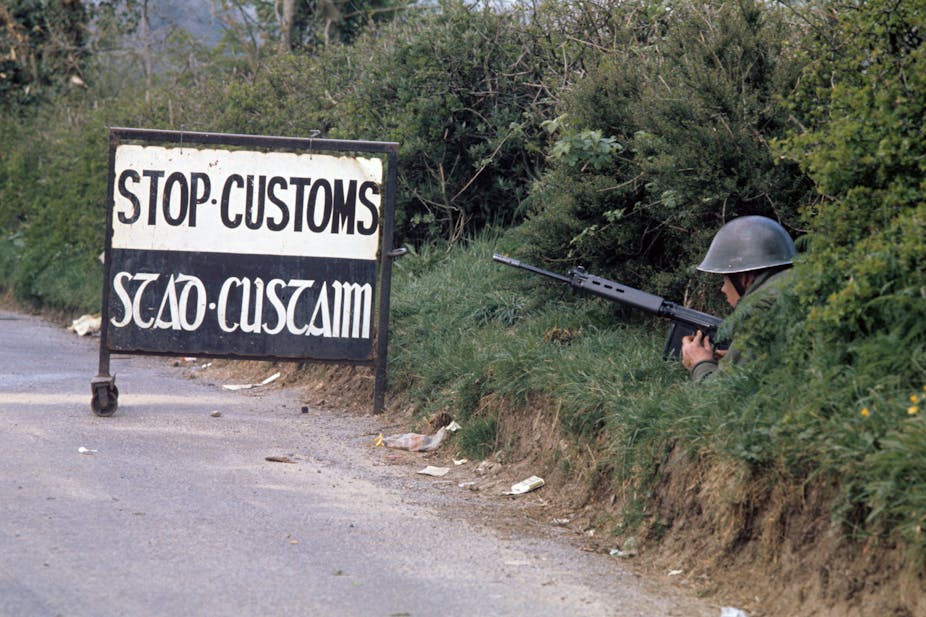Central to the fate of the Brexit negotiations is the future of the Irish border. Politicians from all sides insist they want to avoid a return to border checks once the UK leaves the EU – but they disagree on how this can be achieved.
The history of smuggling across the Irish border – and what already happens today – is a major issue in this disagreement, yet it has received relatively little attention.
In 1923, soon after the end of the Irish war of independence, British and Irish customs authorities agreed on 15 “approved frontier crossing points” on cross-border roads for the inspection of goods in daytime hours. At each point, a border customs checkpoint or “customs hut” was set up. Many unapproved routes crossing the border remained open to pedestrians but travelling on them by vehicle was prohibited. The exception was a small number of “concession roads” on which vehicles could travel from one part of a jurisdiction, passing through another jurisdiction, and re-enter the original one without stopping.
Travellers with contraband on unapproved routes risked detection with penalties enforced by customs patrols. Smuggling became a widespread feature of borderland life between the 1920s and 1960s as borderlanders and those from further afield sought to avoid paying duty on goods bought on the other side of the border.
This period is replete with tales of small-time, domestic smuggling – tea and butter concealed beneath a petticoat in wartime, whiskey and a turkey beneath a heavy overcoat at Christmas time. Even commercial smuggling stories, usually involving the transportation of animal livestock in some unusual way, were told to generate amusement, even admiration, rather than outrage.
Northern Ireland’s Troubles, beginning in 1969, suppressed smuggling activities because many unapproved routes were closed or blown-up by the British security forces. For many people, the presence of British Army checkpoints at approved crossing points also provided a sufficient disincentive for cross-border travel.
An end to border checks
The launch of the European single market on January 1, 1993 – to provide free movement of goods, services, people and capital within the European Union – made border customs checkpoints redundant because import duties on goods were no longer applied. But excise duties on fuel, alcohol and tobacco remained.
Smuggling across the border then became a highly profitable, niche activity that was the preserve of well-organised gangs who have largely concentrated on smuggling tobacco and fuel. The smuggling of counterfeit cigarettes – manufactured in Eastern Europe and Asia – into Ireland and across the border was identified in 2018 as a significant threat by Her Majesty’s Revenue and Customs (HMRC).
In March 2018, an illicit tobacco factory manufacturing cigarettes from raw tobacco destined for the UK market was discovered in County Louth, south of the border. Fuel smuggling also remains a significant issue despite the success of HMRC’s anti-fraud strategy which contributed to the shrinking of the Northern Ireland illicit diesel market share from 19% in 2005-6 to 6% in 2016-17.
Post-Brexit opportunities for smugglers
It is entirely possible that the activities of such organised smuggling operations could be turbo-charged by a no-deal Brexit which would bring with it import and export duties between Northern Ireland and the Republic of Ireland and regulatory divergence for a wide range of commodities. The golden rule of smuggling is that where there is a difference in the price of a commodity, or it is in short supply on either side of a border, smugglers will seek to step in and make a profit. The organised and experienced smugglers are the most likely candidates to reap the illicit rewards.

An upsurge in smuggling would be facilitated by the most extensive cross-border road network in Europe. Officially, there are 208 cross-border roads on the island, nearly twice as many as those crossing the EU’s entire eastern external frontier. A security response to that upsurge would be inevitable. One possible retrograde step could be to close scores of the secondary cross-border roads that were reopened in the 1990s with the support of EU funding.
Read more: How the EU played a key role in smoothing relations between London and Dublin
Technology could also be deployed. Motion sensors, scanners, and infra-red and surveillance cameras could be erected on border crossings. But they could also be knocked down in the dead of night. A 2018 survey conducted in the central border region found that a majority of the 600 respondents claimed they would not accept border control technology even if it was unmanned and not at the border.
Mobile security patrols along the unwieldy 500km of the Irish border would be almost irresistible, not least to help protect vulnerable customs officials and agrifood inspectors working in isolated border terrain. Such an introduction is made more likely by the fact that the peace and openness of the borderlands for 20 years, courtesy of European integration and the Irish peace process, has led to the closure of 40% of police stations on either side of the border. So it’s also likely that new security personnel would be drafted in from outside and would be unfamiliar with the area, unknown to borderlanders, and characterised by them as “nameless strangers”. Alienation and antagonism would seep into the borderlands as a result.
Chiefs of police on both sides of the border are acutely aware of potential post-Brexit challenges. These difficulties are posed not only by the possible return of alienation, antagonism, and by the likely strengthening of politically-motivated “dissident” Irish republicanism, but also by well-organised, cross-border smugglers motivated by profit.

